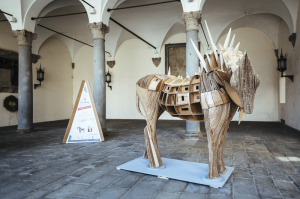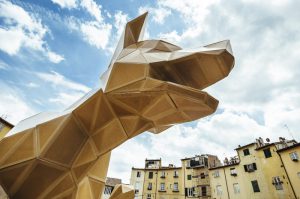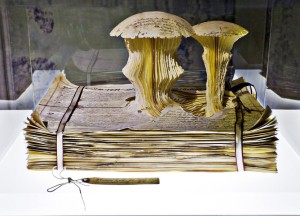
In Italy, in the region of Tuscany, paper manufacture has taken on the district characteristics, linking its image to the land to which it belongs and having a considerable impact on the whole area, economically, environmentally, socially and culturally. The Cartasia project is part of this territorial framework through the language of contemporary art and events. It is an International Festival, an artistic and cultural project, with environmental objectives, aimed at uniting art and one of the main industries of Tuscany: paper.
A two-yearly event, its seventh edition was held in 2014, dedicated to the theme of Liquid Identity, expressed through art, economy and society. Various initiatives featured at the occasion: competitions, exhibitions and events.
The centre of the event was the international competition between the designs of artists from all over the world, which were subsequently selected by a panel of experts. The works chosen were displayed in the squares and roads of the city where they could be admired and there could be interaction. The artistic installation therefore, placed in the environment of the town, comes to life: the works have their own space which can be seen, felt and crossed through. Furthermore the coinciding of Cartasia’s ten-year anniversary with the five hundred years of the Lucca city walls has allowed the re-installation of some of the best sculptures from past editions, placed in the terraces of the city walls. And as a corollary to the installations en plein air, exhibitions, events and performances created a rich calendar of initiatives throughout the whole Biennial month.
International Outdoor Exhibition & Academy Outdoor Exhibition
Starting with the International Outdoor Exhibition, show-piece of the Biennial, this year six finalists out of 300 competing designs were chosen, and they displayed their paper monuments in Lucca’s squares. And in honour of Cartasia’s ten year anniversary, together with these sculptures, three sculptures from past editions were also displayed. Winner of this year’s edition was the Polish artist Kamila Karst, with his Kataphraktos, a horse made entirely from cardboard (see photo). Here is an overview of the artists:
- Lorenzo Bergamini presented the work Take care, which was placed in Lucca’s historic centre, in Piazza San Frediano. The installation represents young trees assisted during the growth phase: the tree acquires multiple symbologies, different depending on culture and historical period. An example is the religious significance which sees the tree as a connection point between earthly space and the sacred dimension; or else it is considered as the symbol of life itself, in particular of evolution and continuous change.
- Giulia Giovannoni presented the work Ovile (Sheepfold), which was placed in Porta San Pietro, also in Lucca’s historic centre: in this work the animals seen as simple instruments of communication between man and nature are placed side by side with the idea of paper as a means of expression and preservation of knowledge, guardian of thoughts and reflections, witness of human beings and their history. The theme “Liquid Identity” is reflected in the idea of the eternal renewal of the spirit and material, offering a starting point for reflection on nature and individuals.
- Kamila Karst, the winner, took part with the work Kataphraktos, placed in the Loggia of Palazzo Pretorio – Piazza San Michele. The structure of the horse is inspired from two realities: the first is that of industrial architecture, the second is that of Hellenic narrative and figurative tradition. The properties of the material particularly determine the shape of the sculpture.
- Emily Nelms Perez presented Solidified, which was placed in Piazza Anfiteatro: a work which documents the transformation of water which assumes the solid form of the she-wolf, whose image depicted here recalls the legend of Romulus and Remus. The story is of two boys who, thanks to the nourishment which the she-wolf gives them, survive and build the Roman Empire. Here the she-wolf symbolises feminine strength, after having abandoned her previous “liquid life”.

Solidified, placed in Piazza Anfiteatro, by Emily Nelms Perez. - Fabio Arrabito created an installation entitled Identità sommerse (Submerged identities) which was placed in Piazza San Martino: The work consists of the reproduction of a wreck of a hull, in two parts, in which one part is underwater and the other is emerging. The boat and the surface which crosses it refer to the complexity of individual identity in post-modern society. With the boat we can identify the subject itself of our time, submerged in its roots from the world which lives. Nevertheless there is one resistant part to this subject: the imagination. It is this that the work seeks to portray.
- Giacomo Zaganelli created an installation entitled Moto (Motion), which was placed in Piazza San Francesco: a sculpture which wants to make people reflect on the idea of point of view. In fact, if observed from the front, it is seen as the image of a circle, but seen from any other viewpoint it will look different each time. A sculpture in continuous transformation which only through the involvement of the public and the act of walking around it can be really understood.
- And finally, not in the competition, Laura Pirro created Orizzonti Fluidi (Fluid Horizons), a work whose ordinary surfaces give way to the Mobius strip: one surface which becomes both internal and external. Just one side and one edge, in a fluid covering which folds the horizons into a liquid spatiality. The space which can be walked through becomes a window on the square, a point of reflection, and a snapshot onto the horizons of one’s time.
The indoor exhibitions
Passing on to the Indoor Exhibit 2014 exhibitions displayed in the historical building of the Real Collegio, this year Cartasia invited national and international artists, experts in working with paper, giving them the whole first floor of the building: Gianfranco Gentile, Li Hongjun, Nicola Tella (here under), Paola Bazz, Richard Sweeney, Sabina Feroci, Vally Nomidou, Valerie Buess, Jorge Faundez Cornejo.
Other initiatives
Another exhibition was created with works created by young people from the higher school art institute in Tuscany. A “School indoor exhibition” competition was also announced for this. Out of all the designs presented only 12 models were exhibited, for creative thinking, keeping to the general theme and for feasibility (approximate) of making the model on a large scale.
Finally there was the events section: great importance was given to this part of Cartasia because through the Meeting For Ideas people talked, discussed, criticised the theme which characterised the whole of the 7th edition, that is, Liquid Identity. The guests, with the relative subjects discussed, are presented in the website section.
Thanks to the Creative Workshops it was possible to involve a public often outside the exhibition/art sector, that is children. Using again the Munari method, Elena Bravi, an expert with a degree in cultural heritage and the history of art, led these children on a journey between the works presented in the exhibition to then get them to create a work similar to one of those shown on the upper floor, demonstrating that art is not so difficult to understand and create.
Finally, the last event, but no less important a one, was the Koski spectacle, in collaboration with the Bagni di Lucca Art Festival. Created by international artists. Their objective was to represent that which made the greatest impression on them of the culture of the place, after spending a period of time there. In fact each spectacle is different, one from the other.
Alongside institutions such as the Municipality, Chamber of Commerce and Province of Lucca, region of Tuscany, MATT, MIBAC, bodies such as Assindustria and the Architects’ Association of Lucca and the considerable support of the Fondazione Cassa di Risparmio of Lucca, the paper mills Ds Smith (main sponsor) and Smurfit Kappa, contributed, giving significant support to the event, adding value and emphasising the important role of art.
Furthermore, this year the Biennial was backed by various new collaborations which helped to ensure the success of the event:
- Oondesign, supporting the setting up of the exhibition with design pieces which made the set-up of the indoor exhibitions modern, elegant and varied;
- “Voglio Vivere Così”, with tastings of local Tuscan products, at the end of meetings where it was usual to confront the speakers who had previously given their speeches;
- Ubik, present at meetings with a stand where it was possible to purchase/consult the books of the speakers in order to go into more depth on the subjects dealt with during the meetings;
- Carpooling, which facilitated logistics, helping the city to be reached by economical and sustainable means.
… many others such as Prismanet.com, l’Opera delle Mura, Econote.it, Dì lucca.it, Il Tirreno, Lucca in diretta.it, L’aperitivo illustrato.
But Cartasia 2014 does not end here: the indoor exhibition of Cartasia, having been greatly appreciated for the topicality of the theme it dealt with and the special works collected, will very probably be exported to San Francisco in 2015. The catalogue of this edition is in the process of being made and will be able to be purchased from the website.

